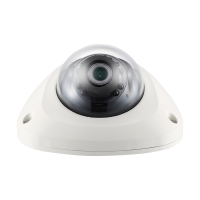36_ setup screen
M
`
If selected <Allow> for IP Filtering and <IPv6 setup> of <IP & Port> is set to <Use>, both IPv4 and IPv6 addresses of the
computer currently configuring should be assigned.
`
The IP address of the computer used for the current setup cannot be added to <Deny>, it should be added to <Allow>.
`
Only the IP addresses that are set to <Use> will be displayed in the filter column.
6. Select an IP to delete from the list.
Click the [Delete (
)] button.
7. When done, click [Apply (
)].
SSL
You can select a secure connection system or install the public certificate for this purpose.
1. From the Setup menu, select the <Network (
)> tab.
2. Click <SSL>.
3. Select a secure connection system.
`
To access the camera using HTTPS mode, you have to type the IP
address for the camera in the form of “https://<Camera_IP>”.
If you failed to configure the Web viewer settings in HTTPS mode with
Internet Explorer, edit the Internet options as follows: <Menu
Tools
Internet Options
Advanced
Security
Uncheck TLS 1.0, and check
TLS 1.1, TLS 1.2>
4. Search for the public certificate that you want to install on the
camera.
To install the certificate on the camera, you need to provide a certificate name (it can be arbitrarily assigned
by the user), certificate file issued from the certification authority and a key file.
`
The <HTTPS (Secure connection mode using the public certificate)> item will be active only if there exists a public certificate
installed.
5. When done, click [Apply (
)].
Installing the certificate
1.
Enter the certificate name.
2.
Click the [
Browse ( )
] button, select the public certificate file and key file to be installed, and then
click the [
Install ( )
] button.
Deleting the certificate
1. Click [Delete ( )] button.
2. To delete a public certificate, you should access the network video decoder in the mode of <HTTP (Do
not use secure connection)> or <HTTPS (Secure connection mode using a unique certificate)>.
802.1x
When connecting network, you can choose whether using 802.1x protocol, and then install the certification.
1. From the Setup menu, select the <Network (
)> tab.
2. Click <802.1x>.
3. Set the <IEEE 802.1x setting>.
• IEEE 802.1x : Specify the use of the 802.1x protocol.
• EAP type : Select EAP-TLS or LEAP.
• EAPOL version : Select version 1 or 2.
• ID : Enter the client certificate ID in EAP-TLS and the user
ID in LEAP.
• Password : Enter the client private key password in EAP-
TLS and the user password in LEAP. You do not have to
enter the password in EAP-TLS if it uses a key file that is
not encrypted.
J
`
If the connected network device does not support the 802.1x protocol, the protocol will not operate properly even if you set it.
`
LEAP is an authentication method with poor security. Use it only in an environment where EAP-TLS is not available.
4. Install/remove the certificate.
The certificate is needed only for EAP-TLS.
• CA certificates : Select a public certificate that contains the public key.
• Client certificate : Select a public certificate that contains the client certificate key.
• Client private Key : Select a public certificate that contains the client private key.
5. When done, click [Apply (
)].
To install/remove 802.1x related certificates
1. Press the [Browse ( )] button for each item and select a certificate to install.
2. If no certificate is installed, you will see “Not Available” appearing next to the selected item.
3. Press the [Install (
)] button to start installation with a message of “Installed” next to the item.
4. Press the [Delete (
)] button to remove the certificate.

